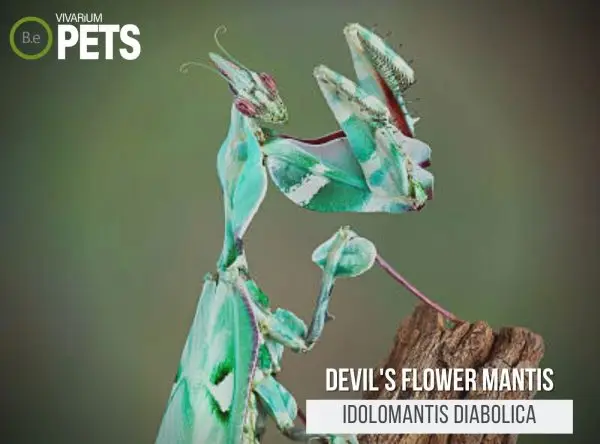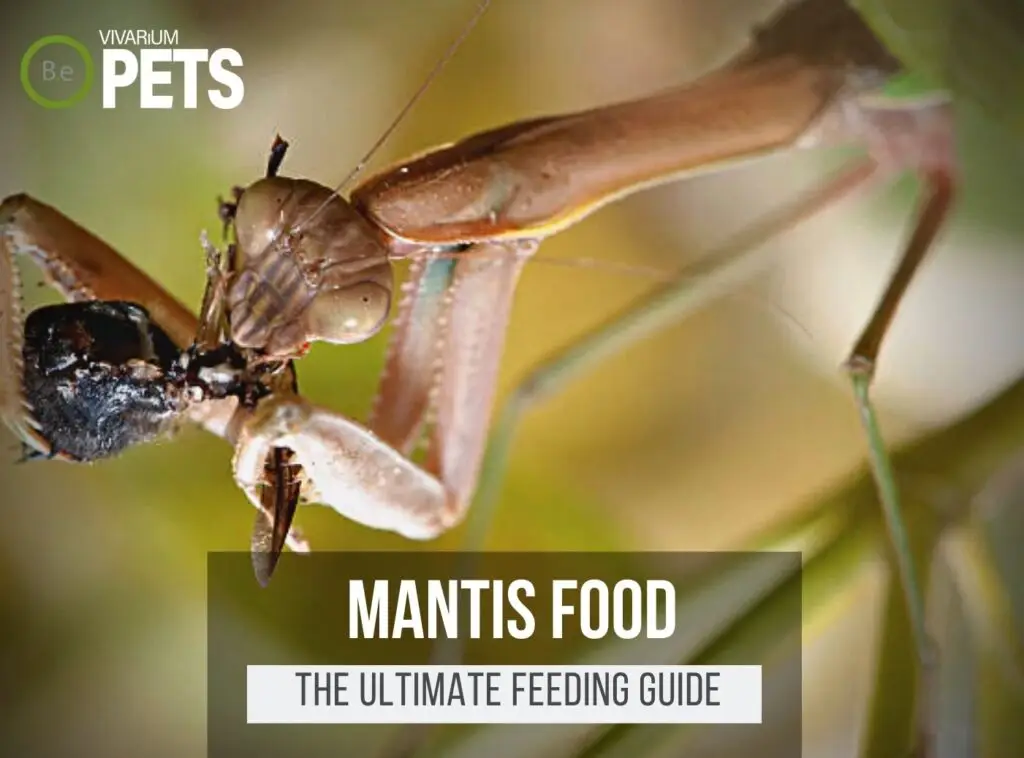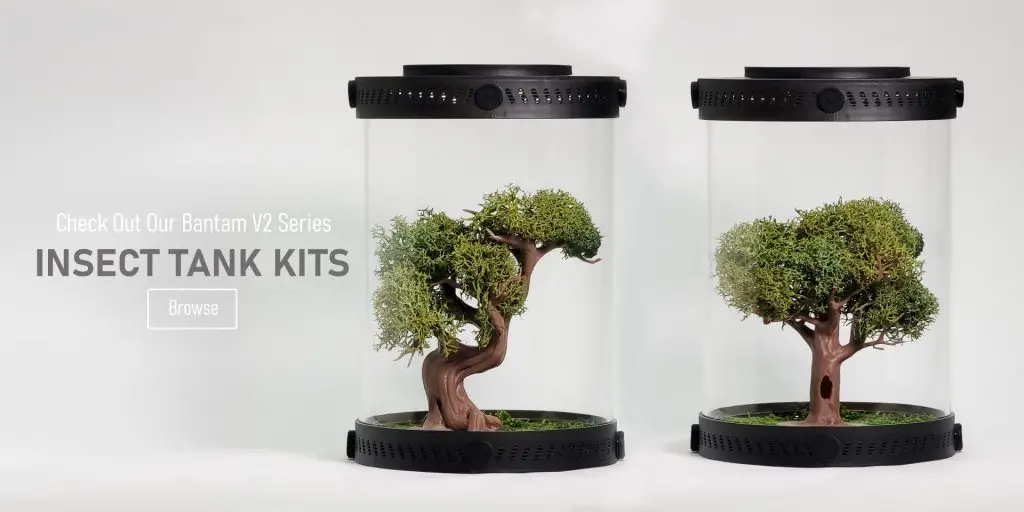I don’t think there’s a more menacing-looking insect than Idolomantis diabolica a.k.a the Devil’s Flower Mantis!
In this article, we’ll review the basics of this unique species, including their appearance, diet, lifespan, and essential care tips.
We’ll also discuss some common problems and questions that may arise when caring for this fascinating species.
Keep reading to learn how to properly care for your very own diabolical flower mantis!
Table Of Contents:
ToggleWhat Are Devil’s Flower Mantis?
The Devil’s Flower Mantis belongs to the family Mantidae and is an exotic species of praying mantis.
This species is native to tropical climates around the world and is known for its large size and unique coloration.
The striking dark brown and cream stripes from which the mantis gets its common name are thought to deter potential predators, while the bright-colored eyes add to the intimidating appearance.
The scientific name – Idolomantis diabolica – translates to ‘devil’s mantis’, making the common name an appropriate one for this fascinating species.
What Does Devil’s Flower Mantis Look Like?
Idolomantis diabolica is a beautiful and unique species of mantis.
Adult specimens have a wingspan of up to 3 inches and are easily recognizable by their striking coloration.
While their top half is usually olive green, bright yellow, or creamish-white, their bottom half and legs are typically bright red or orange.
They also have bulging red or yellow eyes, which gives them an almost alien-like appearance.
When at rest, Devil’s Flower Mantises usually hold their front legs slightly curled as if they were praying.
Like other mantises, they have spiny forelegs and powerful grasping claws, which they use to capture their insect prey.
They also have long, thin antennae that they use to detect movement.
I. diabolica are among the larger mantis species, with females growing to be about 5 inches in length and males growing to be about 4 inches long.
Their wings are filled with iridescent blues, greens, and yellows, creating a stunning array of colors that can be admired as they fly around.
Benefits Of Using Devil’s Flower Mantis
Idolomantis diabolica offers a unique and captivating sight to many types of vivariums.
This bold and brightly colored species can be a great addition to any living space, providing hours of entertainment and interest.
Not to mention, their often shy, but sometimes bold, behavior can make them a great centerpiece in enclosures as they explore the nooks and crannies on the hunt for prey.
They’re also incredibly low-maintenance, requiring little in terms of specialized care and upkeep.
As a pet, these types of mantes make unusual companions to have and will provide a unique opportunity to study the inhabitants in a controlled ecosystem.

Devil’s Flower Mantis Facts
The Devil’s Flower Mantis is a unique and eye-catching species of praying mantis native to Africa and the Middle East.
They feed mainly on small insects, such as flies, have a calm and docile temperament, and can live up to 12 months in captivity.
Breeding requires a cool, dry environment as well as conditions that mimic their natural habitat.
Habitat
Idolomantis diabolical is believed to have originated from the tropical rainforests of Africa and Asia.
They are also found in some parts of Europe and India.
In their natural habitat, Devil’s Flower Mantis is usually found in lowland wooded grasslands and tropical rainforests, seeking shelter near plants and rocks.
They are especially attracted to light colors such as pink or yellow for camouflage.
These creatures are solitary and nocturnal, lying in wait for prey to appear.
When disturbed, they may even lift their wings and open their “mouth” wide, resembling a crocodile in a threatening posture.
Create the perfect home for your mantis with our Customizable Mantis Enclosure Kits, designed to meet all their habitat needs.
Diet
The Devil’s Flower Mantis is a voracious insectivore, which means they primarily feed on other insects.
In their native habitat, they feed on crickets, grasshoppers, moths, and other small insects.
They can also consume some small spiders, though this is less common.
It’s important to provide variety in their diet to ensure that they get all the nutrients they need.
When hunting, Idolomantis diabolica will often lay in wait for their prey.
They have excellent predatory instincts and can be quite stealthy in capturing their prey.
They are opportunistic predators and will consume whatever they can find.
When their prey approaches, the mantis will quickly strike, catching the insect in its powerful legs before devouring it.
They are adept at blending themselves against their environment, making them difficult to spot.
Temperament
The Devil’s Flower Mantis are gentle and docile creatures that rarely display aggression towards humans or other animals.
They can make good companions for humans and usually prefer not to be handled.
If handled, they can become stressed and are likely to quickly attempt to escape.
Though they are fairly peaceful with other mantids, they are incredibly territorial and will likely fight or eat other mantids in their enclosure.
In general, it’s best to keep the Devil’s Flower Mantis’ enclosure separate from other insects and animals to minimize aggression and promote safety.
However, they are not easily spooked and can co-habitat well with non-insect animals like lizards.
As long as both animals are properly fed, they can live peacefully in the same enclosure.
Lifespan
Idolomantis diabolica has a relatively short lifespan of 12 months.
This species has multiple stages in its life cycle: egg, nymph, subadult, and adult.
Nymphs are very small when they hatch from their eggs, measuring only a few millimeters in length.
Throughout several molts, they gradually grow in size and reach adulthood after a few short months.
During this time, they need to have access to food, water, and the correct environmental conditions to survive.
After reaching adulthood, the Devil’s Flower Mantis will live for another 5-8 months before dying.
During this time, it is important to continue providing it with the necessary resources for it to remain healthy.
Breeding
The mating process for Devil’s Flower Mantis is relatively uncomplicated.
The male and female will meet, the female will “taste” the male with her antennae, and then proceed to signal her acceptance or rejection to him with her front legs.
If she accepts him, she will turn into an S-shape and the two will mate.
After mating, the female will lay anywhere from 10-20 ootheca (egg sacs) over 4-6 weeks.
It’s important to keep the egg sacs from getting too wet, as this could potentially cause them to rot or mold.
At the right temperature, the eggs will hatch after 8-10 weeks.
Once hatched, the baby mantids are independent and do not need to be a part of a colony.
Where To Find Devil’s Flower Mantis
If you’re looking to find Idolomantis diabolica, they are typically found in Africa, mainly in the Sahelian and Sudanian zones.
They can also be found in other parts of North and West Africa throughout the Littoral zone.
However, they seem to be rare and can be hard to find in the wild.
You can also find Devil’s Flower Mantises for sale online, although they may come with an expensive price tag.
If you purchase one from a reputable dealer such as a local pet shop, you can be sure that it is healthy and well-cared for.
Finally, you may be able to find Devil’s Flower Mantises in rescue centers or sanctuary facilities.
Adopting a mantis in need can be a rewarding experience, as you can provide a loving new home for a mantis that needs a loving caretaker.
Devil’s Flower Mantis Care
Idolomantis diabolica needs a properly set up habitat, regular feedings of nutritious food, and a temperature and humidity level suitable for their needs.
Do your research before adding a mantis to your habitat, and be sure to watch for common health and behavioral issues.
With the right care, you can enjoy the beauty of the Devil’s Flower Mantis!
Tank Requirements
To ensure that your Devil’s Flower Mantis stays in tip-top condition, it’s necessary to create the right environment in its tank.
Ideally, the tank should be a glass terrarium at least 5-10 gallons in size, as this allows for adequate air circulation.
The water and soil pH should be 7.2-7.4, hardness should be at least 4 dGH, and the temperature should measure between 74-84 degrees Fahrenheit.
For terrarium soil, a mix of Sphagnum moss and coco fiber works best.
Additionally, the tank should provide some shade and have low-level terrarium lighting for night-time temperatures.
All of these elements should ensure that Idolomantis diabolica is well cared for and happy.
What Does Devil’s Flower Mantis Eat?
Feeding Idolomantis diabolica is relatively simple.
You’ll want to offer them a variety of small insects such as crickets, flies, and moths.
Be sure to only offer the Devil’s Flower Mantis insects that are no larger than the size of their body, as anything larger may potentially be dangerous.
It’s also essential to make sure all of the insects you offer your mantis are gut-loaded and dusted with nutritional powder.
Here is a list of insects you can offer your I. diabolica:
- Crickets
- Flies
- Moths
- Mealworms
- Waxworms
- Grasshoppers
- Fruit Flies
- Earthworms
- Butterworms
If you’re looking for a more detailed approach to feeding these critters, be sure to check out my ultimate DIY Praying Mantis food guide. I give a more in-depth explanation of the best foods and my favorite recipe.
Best Tankmates For Devil’s Flower Mantis
One of the best tankmates for the Devil’s Flower Mantis is the African Leaf Insect.
Like Idolomantis diabolica, African Leaf Insects are slow-moving and generally docile, providing a peaceful atmosphere in the exhibit.
They also have a similar care requirement and can live for years—long enough to become a beloved companion of the Devil’s Flower Mantis.
Other potential tankmates for the Devil’s Flower Mantis include isopods, springtails, terrarium snails, and millipedes.
These species are all nonaggressive and make healthy treats for active hunting, making them ideal tankmates for the Devil’s Flower Mantis.
When keeping any tankmates with the Devil’s Flower Mantis, it is vital to make sure that they are of similar size and temperament.
Monitor all animals closely and remove any overly aggressive tankmates right away.
With the right care, the Idolomantis diabolica and their tankmates can co-exist peacefully in the same exhibit.
Conclusion
We hope you come away from this article with a greater appreciation of this pet mantis, an impressive and beautiful species.
By taking into account their unique diet, temperature, humidity requirements, and health issues, you can fully enjoy raising and caring for this precious species.
Thank you for taking the time to read our Idolomantis diabolica care guide!
Create the ideal habitat for your praying mantis with our species-specific soil mixes and Insect Enclosure Kits. These products provide everything you need for a thriving Mantid habitat.
Frequently Asked Questions
No, Devil‘s flower mantis are not poisonous.
No, Devil‘s Flower Mantis are not harmful; they are not venomous and very rarely bite people.
Yes, Devil flower mantes are fairly rare and are not found in many places.
The Devil‘s Flower Mantis is a species of mantis that is known for its showy, brightly colored hindwings. It locates and attacks prey by startling them with its vibrant wings.
Devil mantises typically live for up to 12 months.
The Devil’s Flower Mantis is found in tropical regions of Africa and Southeast Asia, including India and Thailand.





